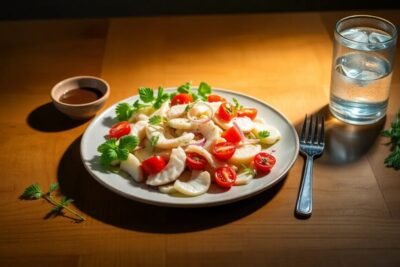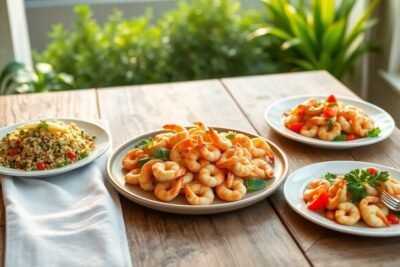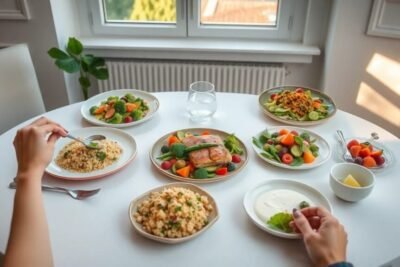
Delicious Diabetes-Friendly Vietnamese Foods You Must Try
- Understanding Diabetes and Nutrition
- Exploring Vietnamese Cuisine: A Healthier Perspective
- Top Diabetes-Friendly Vietnamese Dishes
- The Art of Portion Control
- Swapping Ingredients for Healthier Options
- Snacking Smart: Vietnamese Snacks That Fit Your Diet
- Meal Prep Ideas for the Week
- Cultural Celebrations and Diabetes-Friendly Eating
- Resources for Managing Diabetes Through Diet
Understanding Diabetes and Nutrition
Diabetes is a chronic medical condition characterized by the body's inability to properly regulate blood sugar levels. Nutrition plays a pivotal role in managing diabetes, which makes it essential for individuals affected by this condition to understand how dietary choices impact their health. The primary focus of diabetes-friendly nutrition lies in controlling blood glucose levels while ensuring adequate nutrient intake.
A fundamental principle of managing diabetes through diet is monitoring carbohydrate consumption. Carbohydrates are the primary source of sugar in the bloodstream, and their intake should be carefully balanced to avoid spikes in glucose levels. For individuals with diabetes, it's important to choose complex carbohydrates over simple sugars, as these release glucose more gradually. Examples of such foods include whole grains, legumes, and certain vegetables, which align with diabetes-friendly Vietnamese food practices.
In addition to carbohydrates, proteins also play a significant role in a well-rounded diet for diabetes management. They promote satiety, thereby reducing the likelihood of overeating, and have a minimal direct effect on blood sugar levels. Lean meats, fish, tofu, and legumes are rich in protein and can be incorporated into diabetes-friendly meal planning.
Fats, while often misunderstood, can also be a part of a healthy diet for individuals with diabetes. It is essential to favor healthy fats, such as those found in avocados, nuts, and olive oil, as they can improve heart health and contribute to overall well-being. Reducing saturated and trans fats is advisable to support cardiovascular health, which is a critical consideration for individuals living with diabetes.
The importance of choosing the right foods cannot be overstated. A balanced and thoughtful approach to nutrition allows individuals with diabetes to maintain steadier blood sugar levels, thus preventing complications associated with the condition. This foundation will provide a useful context for exploring specific Vietnamese dishes tailored to meet the dietary needs of those managing diabetes.
Exploring Vietnamese Cuisine: A Healthier Perspective
Vietnamese cuisine is renowned for its vibrant flavors, fresh ingredients, and unique cooking techniques, making it an appealing option for individuals managing diabetes. At the heart of this culinary tradition is a harmonious blend of vegetables, herbs, and lean proteins that collectively contribute to the creation of diabetes-friendly Vietnamese food. These elements not only enhance taste but also play an essential role in promoting a balanced diet.
One of the standout features of Vietnamese cooking is its emphasis on fresh produce, which serves as the foundation for many dishes. Vegetables such as bok choy, radish, and various leafy greens are commonly incorporated, providing essential vitamins, minerals, and fiber while being low in calories and carbohydrates. This focus on fresh ingredients helps ensure that meals remain nutritious without causing significant fluctuations in blood sugar levels.
Herbs are another hallmark of Vietnamese cuisine, with ingredients like cilantro, mint, and basil frequently included in dishes. These herbs not only elevate flavors but also carry numerous health benefits. Many herbs have anti-inflammatory properties and can aid in digestion, which is particularly beneficial for those with diabetes looking to maintain their overall health.
Moreover, lean proteins, including chicken, tofu, and seafood, are essential components of Vietnamese meals. These protein sources are lower in saturated fats and calories compared to red meats, making them a healthier choice for individuals monitoring their blood sugar. The combination of lean proteins with fiber-rich vegetables creates a satisfying meal that promotes satiety and helps manage hunger, two vital aspects of diabetes management.
In conclusion, the characteristics of Vietnamese cuisine make it an excellent option for individuals seeking diabetes-friendly food. By focusing on fresh ingredients, aromatic herbs, and lean proteins, Vietnamese dishes can provide flavorful and healthy meals that support the management of blood sugar levels while satisfying the palate.
Top Diabetes-Friendly Vietnamese Dishes
Vietnamese cuisine offers a rich tapestry of flavors and textures, making it an exciting option for those seeking diabetes-friendly meals. Among the notable dishes, pho stands out not only for its aromatic broth but also for its customizable ingredients. Typically made with lean proteins such as chicken or beef and an abundance of fresh herbs, pho can be adapted easily by opting for whole grain noodles or reducing the portion of noodles, thus lowering the carbohydrate content while maintaining the dish's essence.
Another exemplary dish is gỏi cuốn, or fresh spring rolls. These rolls are typically made with rice paper wrapped around a mix of vegetables, fresh herbs, and shrimp or grilled chicken. This dish is particularly beneficial due to the high fiber content from the vegetables, which can help manage blood sugar levels. Opting for a homemade hoisin or peanut sauce, used sparingly, can also enhance flavor without significantly adding to the glycemic load.
In terms of salads, gỏi đu đủ, a papaya salad, serves as a refreshing and diabetes-friendly option. Prepared with green papaya, nuts, and a light dressing of lime juice, this salad satisfies the palate while providing essential nutrients without the use of added sugars. The crunchiness of the papaya combined with the protein from nuts promotes satiety and helps in controlling blood glucose levels, making it a suitable choice for individuals with diabetes.
Main courses such as chè đậu xanh, a mung bean pudding, can also be modified to be diabetes-friendly. Using minimal sugar and incorporating coconut milk can create a delightful dessert while allowing for portion control. These dishes showcase the versatility of diabetes-friendly Vietnamese food, providing a spectrum of tastes that align well with the dietary needs of those managing diabetes.
The Art of Portion Control
When it comes to enjoying the rich flavors of Vietnamese cuisine while managing health, particularly for individuals with diabetes, portion control plays a crucial role. Understanding appropriate serving sizes can help maintain balanced blood sugar levels while still indulging in diabetes-friendly Vietnamese food. To effectively manage portions, it is essential to familiarize oneself with the recommended serving sizes for various food groups typically found in Vietnamese dishes.
For instance, a typical serving of rice is about one quarter cup cooked, which is approximately the size of a small fist. This amount allows for the enjoyment of staple foods without overwhelming the meal with carbohydrates. Similarly, controlling protein portions such as lean meats, tofu, or seafood should aim for a serving size around three ounces, roughly the size of a deck of cards. Vegetables should fill half the plate, as they are integral to many Vietnamese recipes and offer numerous nutrients without excess carbohydrates.
Visual aids can be particularly beneficial for understanding portion sizes. Utilizing smaller plates and bowls can help create an illusion of a fuller plate when serving diabetes-friendly Vietnamese food. Additionally, employing measuring cups and spoons initially can establish a foundation for recognizing portion sizes intuitively. Moving forward, consider the practice of mindful eating—taking time to savor each bite helps in recognizing those early signs of fullness.
Overall, embracing these portion control strategies will not only contribute to better blood sugar management but also allow individuals to enjoy the delightful diversity of Vietnamese dishes. By balancing the plate with controlled servings, one can take full advantage of the flavors and benefits that this cuisine offers without sacrificing health.
Swapping Ingredients for Healthier Options
Vietnamese cuisine is renowned for its vibrant flavors and fresh ingredients. However, for individuals managing diabetes, traditional recipes often require modifications to make them more diabetes-friendly. One effective approach is to swap high-sugar or high-carbohydrate ingredients with healthier alternatives that do not compromise the dish's authentic taste.
One of the most common high-carb ingredients in Vietnamese cooking is rice. Instead of using white rice, consider substituting it with brown rice or quinoa. These whole-grain options have a lower glycemic index and provide more fiber, making them a better choice for maintaining stable blood sugar levels. This substitution works well in dishes like cơm tấm, a popular broken rice plate, where the nutty flavor of brown rice can enhance the overall experience.
Additionally, sugar is a prevalent ingredient in many Vietnamese dishes, such as sauces and marinades. To create diabetes-friendly versions, use natural sweeteners such as stevia or erythritol, which have little to no effect on blood glucose levels. A traditional fish sauce dip, for example, can be modified by reducing the sugar content and incorporating lime juice or vinegar for zing, allowing you to retain the dish’s essence while making it suitable for a diabetic diet.
Another consideration is the use of vegetables. Traditional recipes often include starchy vegetables like potatoes. By swapping them for non-starchy options such as zucchini or bok choy, you can reduce the overall carbohydrate load while still enjoying a satisfying texture and flavor. These substitutions not only cater to a diabetes-friendly Vietnamese food approach but also encourage a greater variety of nutrients.
Ultimately, by implementing these ingredient swaps, you can enjoy the rich culinary traditions of Vietnam while adhering to dietary needs. Innovations in recipes allow for maintaining the culinary integrity while promoting healthier eating habits for those managing diabetes.
Snacking Smart: Vietnamese Snacks That Fit Your Diet
For those managing diabetes, finding enjoyable and compliant snacks can be a difficult task. However, Vietnamese cuisine offers a variety of snacks that can align well with a diabetes-friendly diet while still delivering on taste and traditional flavors. Here are some delightful options that provide both satisfaction and nutritional value.
One popular choice is bánh gạo or rice cakes, which are typically low in calories and can be topped with various healthy ingredients, such as peanut butter or avocado. These toppings not only enhance the flavor but also add healthy fats and proteins. When consumed in moderation, rice cakes can serve as a satisfying snack without spiking blood sugar levels.
Another excellent option is cà rốt chấm tương đen, which consists of carrot sticks dipped in black bean sauce. This snack is high in fiber and antioxidants, making it a great choice for blood sugar management. Fiber-rich snacks like this can help slow down glucose absorption, keeping levels more stable.
For those looking for something savory, consider chả giò, or Vietnamese spring rolls, which can be prepared using vegetable fillings and a thin layer of rice paper. Baked spring rolls are a healthier alternative to the traditional fried variety and can be packed with vegetables such as cabbage, carrots, and mushrooms. This variation not only reduces fat and calories but also maximizes nutrient intake without compromising taste.
Lastly, đậu phộng rang, or roasted peanuts, make for a quick and satisfying snack. Peanuts are rich in protein and healthy fats, providing sustained energy without causing blood sugar spikes. However, portion control is essential, as peanuts are calorie-dense. Opting for unsalted or lightly salted varieties ensures that these snacks remain mindful of sodium intake.
With these delicious diabetic-friendly Vietnamese snacks, you can enjoy flavorful options that align with your dietary needs, making snacking both enjoyable and health-conscious.
Meal Prep Ideas for the Week
Planning and preparing meals in advance can significantly benefit individuals managing diabetes. By organizing a week’s worth of diabetes-friendly Vietnamese food, you can ensure that healthy meals are readily available and reduce the temptation of unhealthy choices. Here are some meal prep ideas that incorporate traditional Vietnamese dishes while focusing on balanced nutrition.
Begin the week by preparing a large batch of goi cuon (Vietnamese spring rolls). Fill these rolls with fresh vegetables, lean protein such as grilled chicken or tofu, and herbs like mint and cilantro. These rolls are not only delicious but also low in carbohydrates. Pair them with a homemade dipping sauce made from low-sodium soy sauce and lime juice for added flavor. Store them in the refrigerator, and they can serve as a quick snack or light lunch throughout the week.
Another idea is to prepare a hearty canh chua (sour soup) using tamarind, vegetables, and a protein source, such as fish or shrimp. This dish is rich in fiber and low in calories, making it a suitable option for diabetes management. Make a large pot and freeze individual portions, allowing you to heat up a serving on days when time is limited.
For a satisfying dinner option, consider crafting a meal that includes thit kho tau (braised pork). Opt for lean cuts of pork and serve it with a side of cauliflower rice to lower the overall carbohydrate count. Prepare extra servings to create a balanced lunch for the next day.
When organizing your meal prep, devote a couple of hours each weekend to cook and store meals in airtight containers. Label them with dates to ensure freshness. By implementing these tips and incorporating various diabetes-friendly Vietnamese food choices, you will save time while maintaining delicious and nutritious meals throughout the week.
Cultural Celebrations and Diabetes-Friendly Eating
Vietnamese culture is rich in traditions and celebrations, often centered around food. For those managing diabetes, adapting these festive meals to be diabetes-friendly can be both a challenge and an opportunity to maintain cultural significance. Traditional recipes can be modified without sacrificing flavor or enjoyment, allowing families to gather and celebrate while being mindful of dietary needs.
One approach is to incorporate more vegetables and lean proteins into traditional dishes, which align well with a diabetes-friendly diet. For instance, classic Vietnamese spring rolls can be made with fresh vegetables, herbs, and smaller portions of lean meats or tofu. This not only enhances the nutritional profile of the dish but also adds a variety of flavors and textures, making it an exciting addition to any celebration. Additionally, utilizing brown rice or quinoa instead of white rice can help manage blood sugar levels while still providing a satisfying base for many meals.
Moreover, when preparing sweet treats, substitutions can be made. Traditional desserts often include rice flour, sugar, and coconut milk. However, using alternatives like stevia or other low-calorie sweeteners can transform these dishes into healthier versions that are still delicious. For instance, a traditional Vietnamese dessert, che, can be created using lower glycemic ingredients for those who need to monitor their sugar intake.
Maintaining traditions while focusing on diabetes-friendly Vietnamese food doesn’t mean foregoing the joys of festive eating. Engaging the entire family in meal preparation can be a delightful way to celebrate these adaptations, fostering a sense of unity in health-conscious eating. By understanding and implementing these modifications, families can enjoy their cherished culinary heritage while being attentive to the health requirements posed by diabetes. This balance allows for an inclusive environment where everyone can partake in the celebrations.
Resources for Managing Diabetes Through Diet
In the pursuit of managing diabetes effectively through diet, particularly with an emphasis on diabetes-friendly Vietnamese food, it is essential to equip oneself with reliable resources. Numerous books and websites focus on understanding diabetes, nutrition, and how various cuisines, including Vietnamese, can fit into a healthy eating plan.
One highly recommended book is “The Diabetes Cookbook for Electric Pressure Cookers” by Ben M. Warden, which features nutritious recipes that keep blood sugar levels in check while satisfying various taste preferences. Additionally, “Diabetes & Heart Health” by Dr. Eva L. Sian is an excellent resource that provides insight into managing diabetes while also addressing cardiovascular health, a common concern among individuals with diabetes.
Online, the American Diabetes Association (ADA) website offers a wealth of information, including meal planning tips that align well with diabetes-friendly options. Their section on healthy cooking offers a variety of recipes, some of which highlight Vietnamese foods. Another useful platform is Diabetes.org, which provides tailored resources on living with diabetes, as well as dietary recommendations that allow for inclusion of flavorful cuisines like Vietnamese.
Social media platforms also host several online communities where individuals share their experiences and tips for maintaining a diabetes-friendly diet. Joining groups like “Diabetes Strong” or the “Diabetic Foodie” community on Facebook can encourage support and interaction with those who share similar dietary goals. These groups often share recipes, including creative and delicious diabetes-friendly Vietnamese food options.
For those looking to immerse themselves in Vietnamese cuisine, consider following culinary blogs that specialize in diabetic-friendly recipes. Websites like “Vietnamese Food with a Twist” provide modified traditional recipes, ensuring that they meet the nutritional needs crucial for diabetes management. By utilizing these resources, individuals can enhance their understanding of maintaining a diet that is both enjoyable and conducive to optimal health outcomes.










